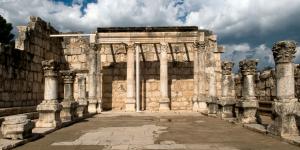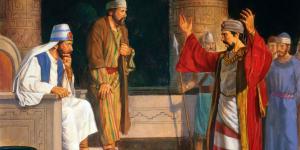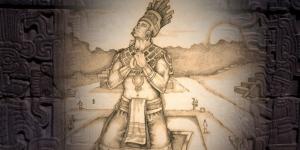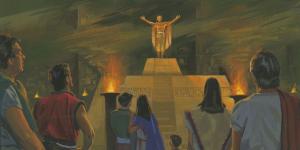You are here
Book of Mormon Central is in the process of migrating to our new Scripture Central website.
We ask for your patience during this transition. Over the coming weeks, all pages of bookofmormoncentral.org will be redirected to their corresponding page on scripturecentral.org, resulting in minimal disruption.
Gospel Doctrine Lesson #27: All Things Denote There is a God

Scripture Block
Alma 30-31
To help class members learn how to recognize and refute false teachings and stay true to their testimonies of Jesus Christ.
Lesson Manual
KnoWhys
Multimedia
Video: BYUtv Discussions on the Book of Mormon: Alma 31-32. Available on BYUtv.org
Video: Interpreter Scripture Roundtable: Book of Mormon Gospel Doctrine 27
Image: Korihor by James Fullmer.
Image: Zoram by James Fullmer.
Chart 35: "Alma as High Priest: Years 9-19 of the Reign of the Judges" from Charting the Book of Mormon.
Chart 36: "Nephihah as Chief Judge: Years 9-24 of the Reign of the Judges" from Charting the Book of Mormon.
Chart 78: "The Teachings of Korihor in Alma 30" from Charting the Book of Mormon.
Chart 109: "Missionary Work" from Charting the Book of Mormon.
Chart 122: "Three Diverse Opponents of the Nephites" from Charting the Book of Mormon.
Chart 145: "Nephite Cycles: Years 1-49 of the Reign of the Judges" from Charting the Book of Mormon.
Articles
Alma 30
"Korihor" in the BYU Onomasticon.
An etymology of the name "Korihor."
John W. Welch, "The Trial of Korihor," in Legal Cases in the Book of Mormon (Provo, UT: Neal A. Maxwell Institute for Religious Scholarship, 2008), 273-300.
The story of Korihor may be initially confusing for some readers, because it seems that Korihor is wrongfully being denied his freedom of speech when he is convicted. However, Welch analyzes the narrative and explains the story in context of ancient Israelite law to show how the trial of Korihor aligns well with ancient Israelite legal practices.
John W. Welch, "Comparing Sherem, Nehor, and Korihor," in Legal Cases in the Book of Mormon (Provo, UT: Neal A. Maxwell Institute for Religious Scholarship, 2008), 301-309.
Although the cases of Sherem, Nehor, and Korihor share certain features with one another, these three actions involving Nephite dissenters have less in common than one might assume. The differences are case-specific and distinctive, as one finds in real-life legal experience, in which no two cases are identical. The distinguishing facts of these cases make the legal value and the historical significance of each one truly unique.
John W. Welch, "Cursing a Litigant with Speechlessness," in Pressing Forward with the Book of Mormon: The FARMS Updates of the 1990s (Provo, UT: FARMS, 1999), 154-156.
The story of Korihor finds resonance with not only Mesoamerican culture, but also Greek culture. When Korihor is cursed with speechlessness, it may be seen as a sign of divine disfavor in Mesoamerican settings. Additionally, similar curses of speechlessness have been observed in ancient Greek culture.
Gerald N. Lund, "An Anti-Christ in the Book of Mormon - The Face May Be Strange, But the Voice is Familiar," in The Book of Mormon: Alma, the Testimony of the Word (Provo, UT: BYU Religious Studies Center, 1992), 107-128.
While Mormon professes that the purpose of the Book of Mormon is to profess the things of Christ, the reader may find perplexity in Alma 30. At a place very near the center of the Book of Mormon, an entire narrative is dedicated to the journey of an Anti-Christ. Gerald Lund addresses this perplexity in the text and provides insight to show that Korihor acts as a foil to other Book of Mormon characters that come forth as stalwart followers of Christ.
Gerald N. Lund, "Countering Korihor's Philosophy," Ensign (July 1992).
Lund approaches the story of Korihor from a philosophical angle in this Ensign article. He explains various fields of philosophy and shows how those different philosophies come out in Korihor's theology. He also uses this discussion as a springboard into how we see these same philosophies at work in the world today, and how one can stay faithful in the gospel.
Bruce A. Roundy and Robert J. Norman, "'All Things Denote There is a God': Seeing Christ in the Creation," Religious Educator 6, no. 2 (2005): 51-62.
Using Alma 30:44 as a springboard, the authors dive into a discussion on how all things in the earth and in nature can be seen symbolically in testifying of God. Through the symbols of rocks, light, water, and vegetation, one can see how God has employed these powerful images throughout scripture to testify of his greatness and glory.
Robert E. Clark, "Notes on Korihor and Language," in Pressing Forward with the Book of Mormon: The FARMS Updates of the 1990s (Provo, UT: FARMS, 1999), 150-153.
In a unique approach, Clark looks at the story of Korihor from a rhetorical stance to analyze the power of his arguments. Clark shows that Korihor artfully uses language to not declare what he believes as truth, but rather to epistomologically tear down the arguments of Alma. Ultimately, Korihor is unsuccessful, as Alma's testimony of God is able to overpower Korihor's skillful rhetoric.
Douglas J. Merrell, "The False Priests of the Book of Mormon," in Selections from the Religious Education Student Symposium 2005 (Provo, UT: BYU Religious Studies Center, 2005): 85-98.
A student essay from BYU comparing the narratives of Sherem, Nehor, and Korihor.
Casey L. Lance, "Korihor, Psychology, and False Doctrine: Korihorian Arguments in Modern Psychology, " in Selections from the Religious Education Student Symposium 2005 (Provo, UT: BYU Religious Studies Center, 2005): 57-71.
A student essay from BYU examining the similarities between Korihor's arguments and the arguments of the modern psychologist.
Michael J. Fear, “Blind Eyes and Hard Hearts: Apostasy in the Book of Mormon,” in Selections from the Religious Education Student Symposium 2003.
The confrontation between Alma and Korihor reveals the progression with which Satan leads hearts away from Christ. Ironically, Korihor condemned the church members for their inability to see clearly.
Alma 31
"Zoram," in the BYU Onomasticon.
An etymology of the name "Zoram".
"Zoramite(s)," in the BYU Onomasticon.
An etymology of the name "Zoramites".
"Rameumptom," in the BYU Onomasticon.
An etymology of the name "Rameumptom".
John W. Welch, "Synagogues in the Book of Mormon," in Reexploring the Book of Mormon (Provo, UT: FARMS, 1992), 193-195.
In Alma 31, the Zoramites worship in synagogues. This may be concerning to some, as synagogues are generally not regarded to have developed until much later than Book of Mormon times. Welch discusses various possibilities to explain the presence of synagogues in the Book of Mormon. There is evidence that synagogues may have developed sooner than traditionally accepted. Also, the word "synagogue" could be a way of connoting a place of gathering, as opposed to an institutionalized Jewish structure.
A. Keith Thompson, "Nephite Insights into Israelite Worship Practices before the Babylonian Captivity," Interpreter: A Journal of Mormon Scripture 3 (2013): 155-195.
The Book of Mormon speaks of synagogues, sanctuaries, and places of worship in a manner which suggests that Lehi and his party brought some form of synagogal worship with them when they left Jerusalem around 600 BC. This essay revisits the most up to date scholarship regarding the origin of the synagogue and suggests that the Book of Mormon record provides ample reason to look for the origins of the synagogue much earlier that has become the academic custom.
Shon Hopkin and Parrish Brady, "The Zoramites and Costly Apparel: Symbolism and Irony," Journal of Book of Mormon Studies 22, no. 1 (2013): 40-53
The Zoramite narratives of Alma 31–35 and Alma 43–44 are richly symbolic accounts woven with many subtle details regarding the importance of costly apparel and riches as an outward evidence of pride. This literary analysis focuses on how Mormon as editor structured the Zoramite narrative and used clothing as a metaphor to show the dangers of pride and the blessings afforded by humble adherence to God’s teachings and covenants.
Matthew L. Bowen, "'See That Ye Are Not Lifted Up': The Name Zoram and its Paranomastic Perjuration," Interpreter: A Journal of Mormon Scripture 19 (2016): 109-143.
The most likely etymology for the name Zoram derives from the Hebrew, meaning, “He [God] has poured forth in floods.” However, the name could also have been heard and interpreted as something like “the one who is high,” “the one who is exalted” or even “the person of the Exalted One [or high place].” This article examines the various etymology possibilities, and provides commentary on its implications for the rest of the narrative. If Zoram carries meaning of being high or exalted, then the Zoramites and their apostasy may represent a type of Latter-day Gentile pride and apostasy, which Nephi, Mormon, and Moroni took great pains to warn against.
Ryan Jenkins, “‘Peaceable Followers of Christ’ in Days of War and Contention,” in Religious Educator 10, no. 3 (2009).
Alma preached to a people who “had fallen into great errors” and who held his authority to preach the gospel in contempt. He preached earnestly “the virtue of the word of God” trusting that “the word had a great tendency to lead the people to do that which was just—yea, it had had more powerful effect upon the minds of the people than the sword, or anything else.”




